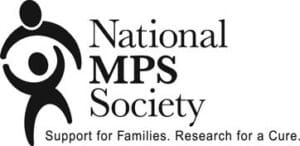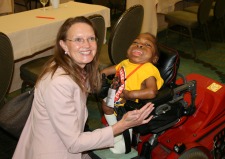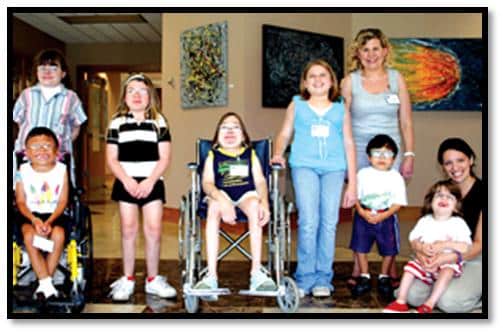Official Studies and More
Research and Grants
Research to understand the causes of these diseases, and to develop better care and eventually therapies for all the Glycoprotein Storage Diseases is a high priority for ISMRD. Learn more about our Research Efforts, Grants, and the Natural History Study.
Our Research Efforts
Events
6 major events over more than a decade to promote sharing of knowledge about the diseases and to encourage more collaboration and research projects. See more details on our conferences.
Alpha-Mannosidosis Research Project
Has partnered with Dr. Troy Lund and Dr. Julie Eisengart at the University of Minnesota to look at the long-term effects of bone marrow transplantation for Alpha-Mannosidosis. The Al-Ansari Grant has provided $170,000 for the project.
Natural History Study
Invested over $70,000 of ISMRD funds in the Natural History Study for our diseases. We did this in partnership with the Greenwood Genetic Center, and supported a successful grant application to the NIH for $250,000 for the study. Part of the $70,000 contribution included a Research Scholarship won by Jenny Noble (ISMRD Board member) for the inclusion of families living in Australia and New Zealand to be part of the Natural History Study. This Scholarship enabled Sara Cathey the lead investigator and her team to travel to Australia and New Zealand. Read the 2018 commentary from Dr Cathey which outlines the development of the study and gives links to numerous publications which resulted from the data gathered.
Research Project on Cardiac Features of Mucolipidosis
Collaborated with the US MPS Society in 2013 to fund a $40,000 research project by Dr. Heather Flannagan-Steet, studying cardiac features of Mucolipidosis, using a Zebrafish model. Click here for the project outline and Heather’s reports in 2014 and 2015 on the study results.
Major Research Fundraisers
Ran successful research fundraisers in 2016 in partnership with other Rare Disease groups worldwide to generate $150,000 for research. This fund was allocated in early 2017 to Gene Therapy research in Mucolipidosis and Osteoporosis research in Mucolipidosis.
Collecting & Gathering Research
Gathering updates from experienced researchers on the state of research on our diseases, showing knowledge progress, future challenges and core publications. More will be added as they come to hand:
- Mucolipidosis review by Dr. Richard Steet. Prepared in 2016 and updated 2018 (View or download PDF)
- Aspartylglucosaminuria review by Professor Ritva Tikkanen, updated Jan 2018 (View or download PDF)
- Sialidosis review by Dr. Sandra d’Azzo updated Jan 2018 (View or download PDF)
- Galactosialidosis review by Dr. Sandra d’Azzo updated Feb 2019 (View or download PDF)
Grants Approved
2016 - ISMRD and its partners fund Gene Therapy Research in Mucolipdisois
Gene Therapy Research in Mucolipidosis
Update, February 2018
ISMRD has received this Year one Report from the research team and provided them with the second year’s funding.
December 2016
ISMRD is delighted to announce on behalf of all our funding partners in the ML Research initiative, the approval of a proposal to begin research on Gene Therapy in ML II.
Allison Bradbury and Charles Vite from the University of Pennsylvania will work with Steven Gray who is based at the University of North Carolina. Their research project will explore the delivery of a healthy copy of the defective gene using a viral delivery system. The ML II cats at the University of Pennsylvania have been the basis for important study of this disease for many years now.
ISMRD launched this ML research initiative early in 2016 and has drawn in vital funding partnerships from the US National MPS Society, the Wagner Foundation, the Spanish MPS Society, Rock4Dakotah, the Australian MPS Society, the Austrian MPS Society, the Irish MPS Society, and many families from around the globe who worked so hard to fundraise for this initiative. Together we raised a stunning $150,000 which has enabled this research to begin.
The formal title of the project is: To evaluate AAV Gene Therapy in the feline model of ML II.
The aims of the project are: Feline mucolipidosis II (ML II) is a model of human ML II, a devastating and incurable disorder that is often fatal in childhood. ML II is an inherited disorder in which one copy of a faulty gene is inherited from each parent. Gene therapy utilizes a virus as a vehicle to deliver a healthy, functional copy of the defective gene.
One specific type of virus, adeno-associated virus (AAV), has been engineered to act as a safe and efficient gene delivery system. Systemic, or intravenous, delivery of AAV has been evaluated in animal models of numerous diseases related to ML II and has recently been approved for a human clinical trial.
In light of recent success in animal models and human patients of similar diseases, we are encouraged that systemic AAV gene therapy holds potential as a treatment for ML II. In this study we will evaluate intravenous AAV gene therapy in the feline model of ML II in order to collect preclinical data to inform human clinical trials.
ISMRD is thrilled with the tremendous support from so many families and groups towards this outcome, and delighted to be supporting this significant new development in research into this serious disease.
The Wagner Foundation
The Irish MPS Society
The Austrian MPS Society
Rock4Dakotah



2016 - ISMRD and its partners fund Osteoporosis in Mucolipidosis II – A Potential Corrective approach
Osteoporosis in Mucolipidosis II
Update March 2018
ISMRD is pleased to have funded the first year of Sandra’s research project and we are delighted to note that continued funding of this work has successfully been obtained from the German Research Foundation. Read Sandra’s year one report here.
December 2016
ISMRD is delighted to announce on behalf of all our funding partners in the ML Research initiative, the approval of a second proposal to begin research on Osteoporosis in Mucolipidosis II – A Potential Corrective approach.
Dr Sandra Pohl works in the section of Biochemistry, Children’s Hospital, University Medical Centre Hamburg-Eppendorf, Germany. Her work will look at how I1-6 may represent a potential target for the treatment of osteoporosis in ML II and ML III.
The aim of the project is: Skeletal alterations are common symptoms in mucolipidosis (ML) II and III patients leading to progressive decline of mobility, stiffness and chronic joint pain, strongly reducing the quality of life. In bone cells of patients the targeting of multiple lysosomal enzymes is disturbed. Consequently, the accumulation of nondegraded storage material in lysosomes impairs the function of bone-forming osteoblasts, osteocytes and chondrocytes of the cartilage. We found that the progressive bone loss in MLII mice is caused by the presence of dysfunctional osteoblasts combined with an increased number of bone-resorbing osteoclasts, which is most likely induced by the strongly elevated expression of the osteoclastogenic cytokine interleukin-6 (Il-6), that could be shown also in MLIII cultured osteoblasts. Therefore,cytokine interleukin (IL-6) may represent a potential target for treatment of osteoporosis in MLII and MLIII to restore correct bone remodeling in patients. The applied experimental in-vivo approach to block Il-6-mediated increase in osteoclast number in MLII and MLIII represents an urgent first step therapeutic strategy, which can profit from the concomitant phase II clinical studies using an Il-6 signaling inhibitor.
ISMRD is thrilled with the tremendous support from so many families and groups towards this outcome, and delighted to be supporting this significant new development in research into this serious disease.
The Wagner Foundation
The Irish MPS Society
The Austrian MPS Society
Rock4Dakotah



2013 - ISMRD partners with the US MPS Society to support Research Investigating the role of Catyhespin Proteases in MLII Cardiac Pathology. Investigator: Heather Flanagan-Steet
Investigating the role of Cathespsin Proteases in MLII Cardiac Pathology - Summary of Project
Heather reports that they have made progress on several aspects of this grant. In addition to progress on the proposed studies, we have made two important advances that will have a major impact on our ongoing pursuit of molecular mediators of MLII cardiac pathology. These include the generation of several unique TALEN-mediated and TILLING based MLII mutant lines. During this year we not only established pure stable lines, but we also confirmed the genetic and biochemical characteristics of these lines. These animals are essential to confirm all of our morpholino-based findings, for analyses of later stage aspects of disease, and for small molecule screens. Importantly, several of the lines exhibit the same craniofacial and cardiac anomalies noted in morpholino-generated animals. Using both TALEN-generated and morpholino based animals, we continue to assess the impact of cathepsin proteases in disease pathology. Toward this goal genetic and pharmacological inhibition studies are beginning to yield promising results regarding the impact of cathepsin during pathogenesis.
Natural History Study
In 2006 the Greenwood Genetic Center in South Carolina, USA began the first ever Natural History Study for Mucolipidosis and offered diagnostic Gene Mutation testing for Mucolipidosis type II and type III. This testing was initiated as a result of the recent publications that positively identified the ML II gene, also know as GNTPA and ML III gene know as GNTPG. ISMRD has partnered with Dr Sara Cathey the lead investigator and the Greenwood Genetic Center to extend the Natural History Study to the other 8 diseases that ISMRD supports.
Read this 2018 commentary from Dr Cathey which outlines the development of the study and gives links to numerous publications which resulted from the data gathered. Numerous publications resulted from the data gathered. The latest is a paper that has just been released concerning intellectual functioning in Alpha-Mannosidosis. Written by Dr Cathey, the paper discusses the findings of the study of the IQ of 12 patients with Alpha-Mannosidosis and data collected from 31 cases from the literature. Read the paper here.
For more information on this study please contact us at info@isrmd.org or via our contact form.
ISMRD and the Greenwood Genetic Center again joined together to host the 3rd round of the Natural History Study which saw more than 30 families participate.
July 2012 – GGC-Charleston Hosts International ISMRD Meeting

North Charleston, SC (August 3, 2012) – The 2012 International Conference for Glycoprotein Storage Disorders was held in North Charleston, SC on July 28-29, 2012. The Greenwood Genetic Center (GGC) co-hosted the event with ISMRD, the International Advocate for Glycoprotein Storage Disorders.
Glycoprotein storage diseases are a group of rare progressive genetic conditions affecting multiple systems of the body resulting in various physical and mental disabilities and often premature death. Concurrent scientific and family meetings brought together clinicians and researchers with families from all over the world. The scientific meeting focused on current research progress and clinical findings for this group of genetic disorders. The family meeting offered information on various therapies, clinical management issues and family support concerns.
Saturday’s sessions ended with a balloon release in memory of those who lost the battle with these conditions.
Dr. Jules Leroy, a senior genetics scholar at the Greenwood Genetic Center, was honored with ISMRD’s Lifetime Achievement Award. Leroy, a former professor and chairman of pediatrics at Ghent University of Medicine in Belgium, discovered mucolipidosis II (I-Cell or Leroy Disease), one of the glycoprotein storage disorders.
Multidisciplinary clinics for 30 patients were also held at GGC’s Charleston office on July 27th and 30th. Dr. Sara Cathey of the GGC’s Charleston office is the principal investigator for a natural history study of these disorders funded by the Lysosomal Diseases Network Consortium Grant and supported by the NIH Office of Rare Diseases. Cathey, an internationally known expert on these conditions, and her colleagues from GGC and MUSC welcomed families from seven countries on four continents who were seeking to further the understanding of these conditions as well as find support from other families facing similar challenges.
“We were so proud to host such talented scientists and inspiring families from all over the world. It is amazing to bring together these researchers with the patients and families who desperately seek more information, research and treatments, “expressed Cathey. “And with these disorders being so rare, this is the only opportunity many of these families have to meet in person. The benefit of that support cannot be overestimated.”
July 2006 – Dr. Sara Cathey called it serendipity. We called it an answer to many prayers.
With the announcement that Dr Sara Cathey would be doing a Natural History Study for Mucolipidosis, families around the world began contacting ISMRD, expressing their interest in taking part in the study. It was hot in July 2006 when families from Arkansas, California, Michigan, New Hampshire, New York, Ohio, and Texas began their journey to Greenwood for the commencement of the Natural History Study. The affected group’s ages ran from 6 to 43. These families were the true Pioneers of the study. Below is an article written during their time in Greenwood.

Pioneers
Families come to genetic center for research into cause, possible cure for rare disorder
July 29, 2006
By Vic MacDonald
Index-Journal regional editor
Children afflicted with mucolipidosis II and III generally are short in stature and have distinctive facial features. They are among the first ever to participate in an extensive clinical study of the disease, conducted at the Greenwood Genetic Center.
Pain tempers the promise of parenthood. Affliction clouds childhood. Fear creeps in – your child is different, and no one knows why. Will he have a normal life? Will she ever dance at her prom? Is there a cure? “No,” the medical community says. Your doctor isn’t sure which direction the treatment should go. Surgery? Drugs? Nothing works. Hopelessness closes in. Ridicule looms. Childhood can be the cruelest of times. “The Pioneers” know all these emotions, and some that the rest of us will never know. Then, suddenly, in a small, far-off city, there’s promise. There’s someone who wants to study your child’s disease. Someone wants you – all of you – to board a plane and fly toward the sun. It’s a new dawn of hope. That someone is Dr. Sara Cathey, and, after the past two weeks, she is armed for battle. She will battle mucolipidosis, a disease so insidious it comes in two types – both distinctive, both maddening.
Dr. Cathey’s armaments are information, research and all the resources of the Greenwood Genetic Center focused on breaking down that most essential of the human building block: the gene. She is going inside your family’s genes and extracting the key. She hopes it’s the key to a cure. Families from all corners of the U.S. and Canada were in Greenwood for tests that Cathey hopes will break the vexing mucolipidosis code.
The cure won’t come right away. The Pioneers know that. But they also know if they don’t get started right now, it will never come.
Linda Nagy, of Chicago, and her family are Pioneers. They brought son Joseph to the Genetic Center for Cathey’s clinical trials, and Nagy said she helped spread the word of the “very exciting” trials through support groups for families dealing with mucolipidosis. “The more people who are involved,” she said, “the more they’ll learn.”
“It is a rare disorder. The numbers are not there to get interest from the drug companies,” Nagy said. “This is very exciting, to have somebody interested in us. This is one of the top facilities in the country.”
For Joseph, the research brings his battle with the disease “full circle,” his mom said. “Our original genetics doctor in Chicago came here,” Nagy said. “When people asked him why, he said, ‘I’ve been invited to sit at the adults’ table.’ So often, doctors know so little (about mucolipidosis). My son was misdiagnosed until age 9.” Joseph underwent a surgery that if the Nagys had known then what they know now, they never would have approved, Linda Nagy said. Even now, 11-year-old Joseph needs hip surgery, but it is being delayed until his body is stronger. Entering the sixth grade, he will cope with traveling distances between classes with the help of a scooter and will use the school elevators instead of stairs. He receives special education instruction because of a learning disability.
“Their care is so extensive. They see so many specialists. That’s why this is important,” Nagy said. “The kids look so different. We wonder what’s ahead in our future. We hope it (Cathey’s research) leads to treatment, but we have to pave the road.” Nagy said Cathey, through her research, has earned herself a loyal following. “Now that we’ve found her, we won’t let her go,” a determined-to-find-a-cure Nagy said. “We’re a very tenacious group of parents.”
“We have to be advocates for our children. It’s a full-time job.”Web site research from the National Institute of Neurological Disorders and Stokes breaks down mucolipidosis types II and III this way: “Mucolipidosis types II and III (ML II and ML III) result from a deficiency of the enzyme N-acetylglucosamine-1-phosphotransferase. Just as luggage in an airport is tagged to direct it to the correct destination, enzymes are often ‘tagged.’ In ML II and ML III, the deficient enzyme is supposed to tag other enzymes (activator proteins) so that they can initiate certain metabolic processes in the cell. Because the activator proteins are not properly tagged, they escape into spaces outside the cell and therefore cannot do their usual work of breaking down substances inside the cells.”
ML II physical signs are “abnormal skeletal development, coarse facial features and restricted joint movement,” and these signs can present themselves at birth. These children die generally before their seventh birthday. Their deaths often result from congestive heart failure or respiratory tract infections. ML II also is known as I-cell disease.
ML III symptoms often do not present themselves until three to five years. These children generally have normal intelligence or mild mental retardation. Some survive until their fourth or fifth decade of life. ML III also is known as pseudo-Hurley polydystrophy.
The future is bleak: “Over time, many children with ML develop poor mental capacities, have difficulty reaching normal developmental milestones, and, in many cases, eventually die of the disease,” the National Institute of Neurological Disorders and Stokes says.
Cathey said what mucolipidosis II and III families want is a measure of certainty, as far as possible through a medical diagnosis, in their lives. Should they make funeral plans or college plans? Fifteen families were involved in two weeks of clinical trials at the Greenwood Genetic Center, and about three dozen families now have their medical histories on file with researchers. Families from New Zealand, Japan, the United Kingdom, Canada and the United States are part of the research. In the Greenwood Genetic Center clinical trials, mucolipidosis II and III patients ranged in age from 5 to 43.
In addition to medical histories, clinical trial evaluations included physical exams, intellectual evaluations, X-rays and some skin biopsies. Cathey said the cells obtained with the skin biopsies will be important for the research that seeks potential treatments. Biochemical and molecular studies were performed on all families. Both parents are carriers of the gene linked to mucolipidosis II and III. They will have one regular gene and one changed gene. When the child inherits the changed gene from both parents, he will have the disease.
“Because it’s so rare, affected individuals vary widely. They usually are short and may be misdiagnosed for years,” Cathey said. “All have gene changes within the same gene. Part of our goal is to figure out how is that. The more we see, the better and broader our understanding of how variable the features may be. Everyone we see has something to teach us.” Every aspect of the Greenwood Genetic Center – more than two dozen people – was involved in bringing in the clinical trial families, making sure they were housed and fed, giving them the medical testing and counseling they needed during the trials and coordinating their returns home. Two Greenwood restaurants, McAlister’s and Beef O’ Brady’s, provided meals and what Cathey called “wonderful hospitality” for the families.
“It was a world-class effort from Greenwood Genetic Center personnel,” she said. There is no immediate cure on the horizon. Cathey said enzyme replacement therapies are being examined and she stressed the importance of the gathering of information. “This is where it has to start,” she said.
“For so long no one had anything to say about this disorder,” Cathey said. “Last fall the gene was published … and it snowballed from there. We decided, ‘We can look at this gene.’ Greenwood Genetic Center announced a study and told families to send your samples. What Cathey called a “well-connected network of families” spread the word worldwide about the Greenwood Genetic Center. She said two families who came for the clinical trials said they had never seen anyone else – ever – with the same disorder their child has. “Talk about being in the dark,” Cathey said.
Now, researchers have a mountain of information to “plough through,” Cathey said. They will pick it apart and look for the common threads among the medical histories. “When you look at as many as possible,” she said, “you can build the natural history of the illness.” Since the mucolipidosis II and III project began at the Greenwood Genetic Center, “everybody wants it to roll fast,” mainly for the families, Cathey said. “This is the orphan of the orphan diseases.” “They feel like it’s their turn, and so do we.”
And when mucolipidosis joins the list of childhood diseases no longer afflicting the world, then parents, children and doctors – all of us, really – can thank The Pioneers.



